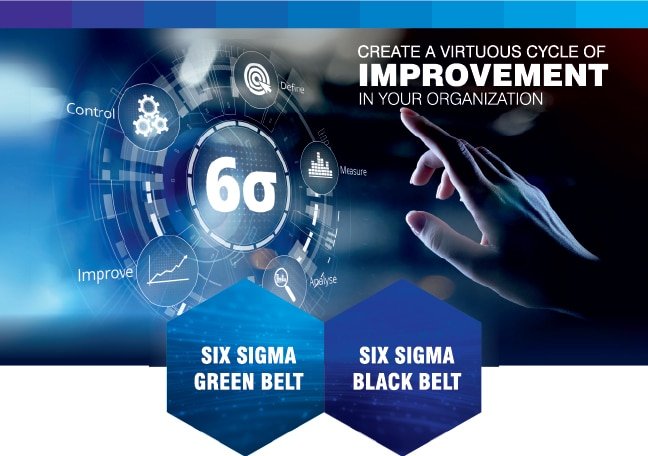Six Sigma is a set of techniques and tools for process improvement. It seeks to improve the quality of the output of a process by identifying and removing the causes of defects and minimizing variability in manufacturing and business processes.
Six Sigma project is a defined sequence of steps to reduce process cycle time, reduce pollution, reduce costs, increase customer satisfaction, and increase profits.
Six Sigma projects follow two project methodologies namely DMAIC methodology and DMADV methodology
Six Sigma projects follow two project methodologies namely DMAIC methodology and DMADV methodology
DMAIC methodology has five phases
- Define the system, the voice of the customer and their requirements, and the project goals, specifically.
- Measure key aspects of the current process and collect relevant data; calculate the ‘as-is’ Process Capability.
- Analyze the data to investigate and verify cause-and-effect relationships. Determine what the relationships are, and attempt to ensure that all factors have been considered. Seek out root cause of the defect under investigation.
- Improve or optimize the current process based upon data analysis using techniques such as design of experiments, poka yoke or mistake proofing, and standard work to create a new, future state process. Set up pilot runs to establish process capability.
- Control the future state process to ensure that any deviations from the target are corrected before they result in defects. Implement control systems such as statistical process control, production boards, visual workplaces, and continuously monitor the process. This process is repeated until the desired quality level is obtained.
DMADV or DFSS methodology has five phases
The DMADV project methodology, known as DFSS (“Design for Six Sigma”)
- Define design goals that are consistent with customer demands and the enterprise strategy.
- Measure and identify CTQs (characteristics that are Critical to Quality), measure product capabilities, production process capability, and measure risks.
- Analyze to develop and design alternatives
- Design an improved alternative, best suited per analysis in the previous step
- Verify the design, set up pilot runs, implement the production process and hand it over to the process owner(s).
Six Sigma Certifications
- Six Sigma White Belt Certification
- Six Sigma Yellow Belt Certification
- Six Sigma Green Belt Certification
- Six Sigma Black Belt Certification
- Six Sigma Master Black Belt Certification
Download the brochure to find out more details about the program
Faculty Profile:
Dr. R.S. Chalapathi
PhD holder from the prestigious IIT, Kharagpur – an expert in Six Sigma.
He is a renowned speaker and author of various books on Six Sigma.
Qualifications:
- PhD in Quality from IIT, Kharagpur
- M.Tech fom IIT, Kharagpur
- B.Tech in Mechanical Engineering
- Certified Lean Master Black Belt
- Certified DFSS Master Black Belt
- ASQ-Certified Quality Engineer
- Certified Lean Six Sigma Master Black Belt
- Certified Trainer from CBI, Netherlands
- Certified Lead Auditor ISO-9000
- ASQ-Certified Manager of Quality and Organisational excellence
International Experience
- Conducted two days open-workshop on Design for Six Sigma (DFSS). Attended by representatives from Motorola, Panasonic, Minolta, etc.
- Provided complete Six Sigma Training and Consultancy to two companies in Dubai: Oman Insurance Company and Dubai Co-operative Society.
- Trained German Engineers on Six Sigma and Facilitated the project implementation. Visited in Germany for 6 weeks during 2003.
- Several people from Sri Lanka, Saudi Arabia and Dubai had attended our Six Sigma Black Belt program in Delhi.


